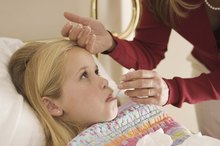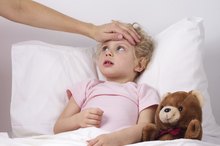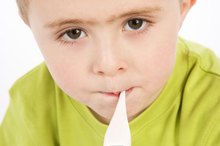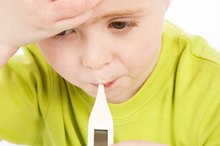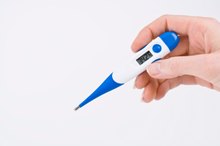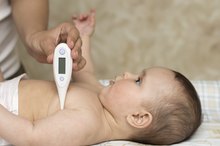What does fact checked mean?
At Healthfully, we strive to deliver objective content that is accurate and up-to-date. Our team periodically reviews articles in order to ensure content quality. The sources cited below consist of evidence from peer-reviewed journals, prominent medical organizations, academic associations, and government data.
The information contained on this site is for informational purposes only, and should not be used as a substitute for the advice of a professional health care provider. Please check with the appropriate physician regarding health questions and concerns. Although we strive to deliver accurate and up-to-date information, no guarantee to that effect is made.
A Child's Temperature Is 103.6: What to Do?
When your child has a fever, particularly a very high one, it can be quite scary. However, if your child has a fever it usually means that her body is actively fighting an infection. Though it is difficult to see your child uncomfortable, most fevers are not life threatening and will resolve when the illness has passed.
Take an Accurate Temperature
If you suspect your child has a fever, it is very important to get an accurate temperature 3. This temperature, in combination with your observations of her behavior, can help you decide whether or not to call the doctor. In young children, the easiest way to obtain a temperature is rectally using a digital thermometer. Digital thermometers can also be used under the arm, though this reading tends to be less accurate. If your child is older, a digital thermometer can be used under the tongue. Ear thermometers are appropriate to use with all children over 3 months of age.
- If you suspect your child has a fever, it is very important to get an accurate temperature 3.
- If your child is older, a digital thermometer can be used under the tongue.
What Is Considered a Fever?
Ways to Tell You're Running a Fever
Learn More
According to MedlinePlus, which is a service of the National Institutes of Health, a rectal temperature at or above 100.4 degrees Fahrenheit or 38 degrees Celsius is considered a fever 23. If you take your child's temperature by mouth, 99.5 degrees Fahrenheit or 37.5 degrees Celsius is considered a fever, and 99 degrees Fahrenheit or 37.2 degrees Celsius is a fever for temperatures taken under the arm 3.
Causes
An illness or infection are the two most common causes of a fever. Fever is a symptom of everything from the flu to pneumonia or appendicitis. In some cases, fever can be a symptom of something more serious, such as cancer or a blood clot. Even immunizations can cause a child to have a fever temporarily. Because there are so many causes of fevers, it is important to take into account any other symptoms your child may be displaying in order to determine whether to seek medical attention.
- An illness or infection are the two most common causes of a fever.
- In some cases, fever can be a symptom of something more serious, such as cancer or a blood clot.
Treatments
Child Running a Fever While on an Antibiotic
Learn More
If your child's fever is being caused by an illness and isn't too high, you will probably be treating it at home. You can do several things to help your feverish child 3. Seattle Children's Hospital recommends that fever-reducing medications like ibuprofen or acetaminophen only be given if your child's fever is over 102 degrees Fahrenheit, though your pediatrician may recommend otherwise depending on your child's level of discomfort 1. Make sure your feverish child is well-hydrated and not overdressed 3. You can also try a cool--not cold--bath to ease the symptoms.
When to Seek Medical Attention
Older children can tolerate higher fevers 1. In infants under 3 months old, a fever of 100.4 degrees Fahrenheit warrants immediate medical attention. According to the experts at MedlinePlus, you should call your child's doctor if your child is between 3 and 12 months old and has a fever of 102.2 degrees Fahrenheit or higher 2. Additionally, if your child is under 2 and his fever lasts more than 24 hours, regardless of temperature, call his doctor 3. For older children, other symptoms should be taken into consideration in deciding how ill he is. However, any fever of 105 degrees Fahrenheit needs to be addressed immediately. If you are ever unsure about your child's health, it is best to be safe and contact his doctor 3.
Related Articles
References
- Seattle Children's Hospital: Fever
- MedlinePlus: Fever
- Kids Health: Fever and Taking Your Child's Temperature
- Gunduz S, Usak E, Koksal T, Canbal M. Why Fever Phobia Is Still Common? Iran Red Crescent Med J. 2016;18(8):e23827. doi:10.5812/ircmj.23827
- American Academy of Pediatrics. Fever and Your Baby. Updated August 3, 2016.
- Torreggiani S, Filocamo G, Esposito S. Recurrent Fever in Children. Int J Mol Sci. 2016;17(4):448. doi:10.3390/ijms17040448
- InformedHealth.org. Fever in Children: Overview. Cologne, Germany: Institute for Quality and Efficiency in Health Care (IQWiG); 2013.
- InformedHealth.org. Fever in children: When to see a doctor. Cologne, Germany: Institute for Quality and Efficiency in Health Care (IQWiG); 2009.
- MedlinePlus. When your baby or infant has a fever. Updated February 13, 2020.
- Lim T. Cleveland Clinic. Kids’ Fevers: When to Worry, When to Relax. Published May 12, 2015.
- Murren-Boezem J. The Nemours Foundation. Fevers. Updated September 2018.
Resources
Writer Bio
Wallis Bishop began writing in 2002. She specializes in issues related to child health, development and parenting. She spent five years teaching toddler and preschool age children and holds a bachelor's degree in psychology, with a specialization in infant and toddler mental health.

